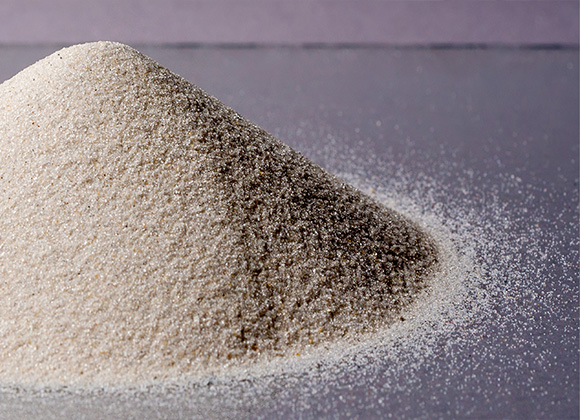Dubai Silica Sand – Source, Properties, Types, and Uses.


Silica sand, a naturally occurring sand with crushed particles of quartz, has proven to be a highly valuable resource for various industries. With its unique properties of hardness, chemical inertness, and high melting point, silica sand is the primary component in the production of diverse products such as glass, ceramics, and concrete.
Silica sand is a type of sand that is composed mainly of silicon dioxide (SiO2) in the form of quartz crystals. It is a widely occurring type of sand found all over the world. The formation of silica sand happens when rocks containing quartz undergo erosion.
The versatility of silica sand goes beyond its elemental composition, as innovators and artists have discovered its granular form to be an integral part of water filtration, hydraulic fracturing, and artistic expression. The abundance of silica sand on earth offers endless possibilities for industries to find new ways to use it, driving technological advancements in multiple disciplines and contributing to the growth of economies worldwide.
To begin with, you need to search for top-notch Silica Sand from reputed companies such as… Alliance Silica.
What is Silica Sand?
Silica sand, also known as quartz sand, is a granular material that contains quartz, along with small amounts of coal and clay. This high-quality industrial sand is produced over time as quartz is gradually broken down into tiny granules by the influence of water and wind.
Silica sand is highly valued in various industries due to its unique chemical and physical properties, including high melting point, strength, hardness, transparency, and excellent thermal stability. The sand is sized and controlled to ensure consistency, and it is not like common concrete and asphalt gravels.
Moreover, manufacturers appreciate silica sand for its abundance and low cost. However, certain applications require consideration of their drawbacks, such as a high rate of thermal expansion, low thermal conductivity, and the potential for releasing silica particles during mining or handling, which can pose respiratory risks to workers.
Sources of Silica Sand.
Silica is a group of minerals that is a combination of Silicon and Oxygen. Its chemical symbol is SiO2 and it commonly appears in the crystalline form. Plankton fossilization caused by weathering is responsible for the crystallization of SiO2.
Silica sand can be found in mines across the globe and is known for its high hardness. The quality of Silica Sand Crystal is determined by the ratio of hardness, silica, and chemical structure of the mines. Silica sand is widely used in both wet and dry industrial applications.
The sources of silica sand come in yellow, beige, and white.
What is Silica Sand Used for
Silica sand is a versatile material that finds its use in various sectors. It is primarily used as a raw material in the construction industry, both in its dry and wet forms. It is also used as filtration sand, moulding sand, and in the production of glass. In industries and manufacturing units, silica deposits that yield at least 95% SiO2 are preferred. Silica has a high melting point and is hard, with SiO2 being used as a measure of industrial sand strength. Silica sand is an essential component in various industrial sectors.

SIGNIFICANT USES OF SILICA SAND
Let’s explore how Silica Sand is used in our daily lives.
MORE DETAILS
- For Glassmaking
- Metal Casting
- Metal Production
- Construction
- Paint and Coating
- Filtration and Water Production
- Oil and Gas Recovery
GLASSMAKING.
Silica sand is a crucial component in the glassmaking industry, serving as the primary ingredient for all types of glass, regardless of their unique properties. Due to its clear and robust chemical purity, silica sand is an indispensable element in every glass formulation. It serves as the primary determinant of glass colour and reinforces glass fibres used in the production of fibreglass insulation.
Industrial sand made from silica sand is a valuable resource used in producing flat glass for automotive and building use, as well as in the production of food, beverages, and tableware containers. Additionally, silica sand is used to produce scientific tools such as test tubes. Glassmaking would not be possible without silica sand, and many industries would suffer greatly.
2. METAL CASTING
Industrial sand is an essential component for both ferrous and nonferrous foundries. The clay is moulded to create the desired external shape, and then metal parts are cast into the sand. Core sands can be recycled mechanically to produce new moulds or cores. The strength of metal parts is dependent on the presence of SiO2.
3. METAL PRODUCTION
Silica sand is the foundation upon which countless products are built. From the soap we use to the cleaners that keep our homes and businesses shining, silica sand plays an essential role in our daily lives. By harnessing the power of this simple yet powerful ingredient, we are able to create a world that is cleaner, brighter, and better in countless ways.
4. CONSTRUCTION
Silica sand is a fundamental ingredient that contributes to the durability and anti-corrosion properties of a wide range of building and construction products. When combined with other materials, it works like magic to enhance their strength and longevity. Its use in various construction materials plays a significant role in shaping the world we live in by creating buildings, roads, and infrastructure that inspire us every day.
5. PAINT AND COATING
Silica Sand is a powerful tool in the hands of paint formulators who strive to create stunning and long-lasting architectural and industrial coatings. Its micron-sized particles contribute to an array of critical performances, including brightness, reflectance, and colour consistency, among others. High-purity silica is particularly effective in achieving these properties. With its ability to improve tint retention, durability, and resistance to dirt, mildew, cracking, and wear, silica fillers are a game-changer in the world of architectural paints.
6. FILTRATION AND WATER PRODUCTION
Silica sand plays a crucial role in ensuring access to clean and safe water for communities. It is not only used for filtering drinking water but also in treating wastewater and extracting water from wells. Silica gravel is an essential packing material in deep water wells, making it possible for us to access this life-sustaining resource. By ensuring that the grain size distribution is appropriate, we can maximize the efficiency of filtration bed operations and make the most of this valuable resource.
7. OIL AND GAS RECOVERY
Frac Sand, also known as Silica Sand, is a remarkable substance in the oil industry. Its hardness and chemical purity make it capable of withstanding even the harshest of environments. Whole grain deposits of Frac Sand can also maximize formation cuttings, making it an essential component in the process of extracting oil. Its resilience and effectiveness are truly awe-inspiring.
Where to buy silica sand?
If you are searching for a high-quality Silica Sand in Dubai -UAE, which can be customised to your specific needs, you may want to get in touch with Alliance Silica based in Dubai downtown.
Related Posts

Silica Sand for Beach in Dubai -UAE
Did you know the sand used in consumer products labelled "Beach Sand" doesn't always come…

Leave a Reply
You must be logged in to post a comment.